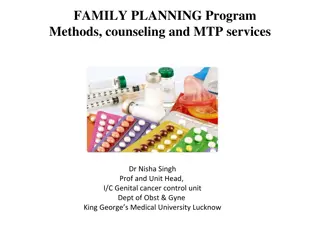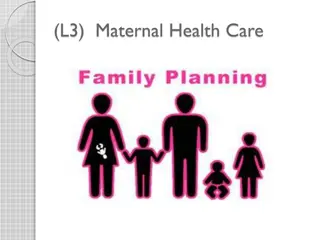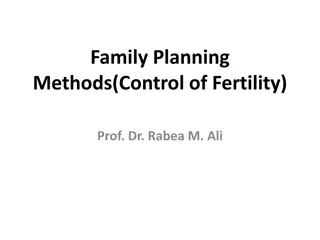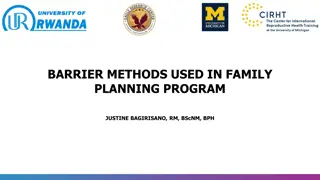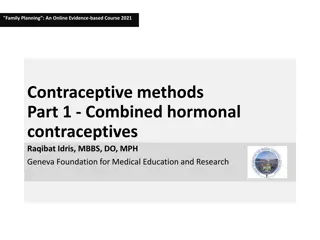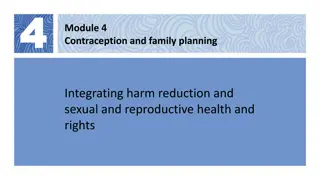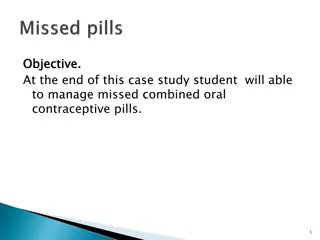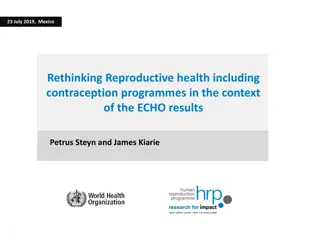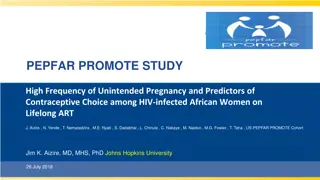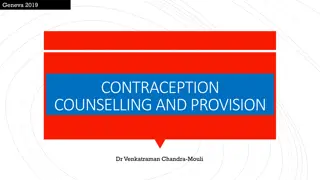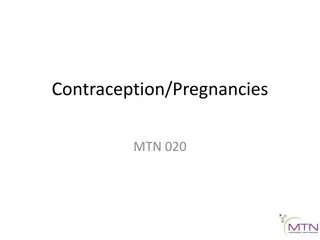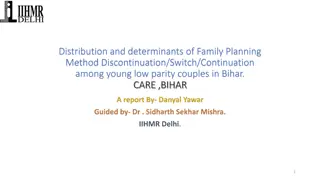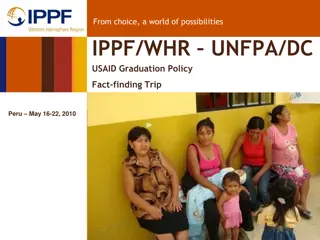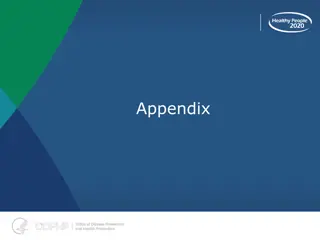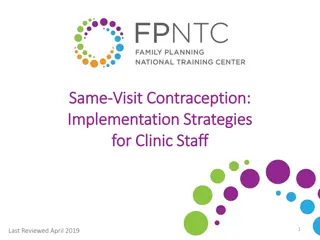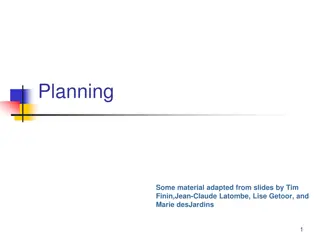Family Planning and Contraceptive Methods: Overview and Benefits
Family Planning and Contraceptive Methods: Overview discusses the definitions, key facts, benefits, and methods of family planning and contraception. It highlights the global need for family planning, the importance of contraceptive use, and the associated health risks and non-health benefits. Emphasizing the significance of contraception in empowering women, promoting sustainable development, and ensuring human rights, the content also addresses the increased risks of pregnancy complications in certain groups of women.
Download Presentation

Please find below an Image/Link to download the presentation.
The content on the website is provided AS IS for your information and personal use only. It may not be sold, licensed, or shared on other websites without obtaining consent from the author. Download presentation by click this link. If you encounter any issues during the download, it is possible that the publisher has removed the file from their server.
E N D
Presentation Transcript
"Family Planning: An Online Evidence-based Course 2021 Contraceptive methods: Contraceptive methods: overview overview Raqibat Idris, MBBS, DO, MPH Geneva Foundation for Medical Education and Research
Outline Definitions Key facts about contraception / family planning Benefits of family planning and contraception Contraceptive methods Comparing effectiveness of family planning methods Contraceptive use by method 2
Definitions What is contraception? Contraception is the intentional prevention of pregnancy by artificial or natural means. What is family planning? Family planning allows individuals and couples to anticipate and attain their desired number of children and the spacing and timing of their births. It is achieved through use of contraceptive methods and the treatment of involuntary infertility. What is an unmet need for family planning? An unmet need for family planning is the number of women that want to stop or delay childbearing but are not using any method of contraception to prevent pregnancy, including also pregnant women whose pregnancies were unwanted or mistimed at the time of conception, and postpartum amenorrhoeic women who are not using family planning and whose last birth was unwanted or mistimed. 3 Training Resource Package for Family Planning Benefits of Family Planning. United Nations, Department of Economic and Social Affairs, Population Division. Contraceptive Use by Method 2019: Data Booklet (ST/ESA/SER.A/435). United Nations; 2019.
Key facts about contraception / family planning Among the 1.9 billion Women of Reproductive Age group (15-49 years) worldwide in 2019, 1.1 billion have a need for family planning; of these, 842 million are using contraceptive methods, and 270 million have an unmet need for contraception. The proportion of the need for family planning satisfied by modern methods, Sustainable Development Goals (SDG) indicator 3.7.1, was 75.7% globally in 2019, yet less than half of the need for family planning was met in Middle and Western Africa. Use of contraception prevents pregnancy-related health risks for women, especially for adolescent girls. Contraception offers a range of potential non-health benefits that encompass expanded education opportunities and empowerment for women, and sustainable population growth and economic development for countries. Only one contraceptive method, condoms, can prevent both a pregnancy and the transmission of sexually transmitted infections, including HIV. Use of contraception advances the human right of people to determine the number and spacing of their children. 4 WHO. Family planning/contraception methods. World Health Organization; 2020.
Increased risk of having problems during pregnancy and delivery Some women have an increased risk of having problems during pregnancy and delivery. They are women who: Are under the age of 18, or over age 35 Become pregnant less than 2 years after a previous live birth Become pregnant less than six months post-abortion or post- miscarriage Have too many children (high parity) Have certain existing health problems Do not have access to skilled health care Problems are more likely in those with multiple risk factors. 5 Training Resource Package for Family Planning Benefits of Family Planning.
Benefits of family planning and contraception Reduces unsafe abortion from unintended pregnancies Prevents maternal morbidity and mortality Reduces newborn and infant mortality Empowers people and enhances education Reduces adolescent pregnancies Helps to prevent HIV/AIDS Secures the well- being and autonomy of women Contributes to Economic Growth 6 WHO. Contraception: Evidence brief. World Health Organization; 2019.
Contraceptive methods There are different types of contraception. They can be short acting or long acting, reversible or permanent. The different methods of contraception have varying rates of effectiveness depending on correct usage. (See next few slides) Health care providers play an important role in helping people find and use a method that is both effective and acceptable. 7
Contraceptive methods Hormonal Emergency contraception (EC) or postcoital contraception Progestogen-only contraceptives 1. Progestogen-only pills (POPs) 2. Progestogen-only injectable contraceptives (POIs) 3. Progestogen-only implants 4. Progesterone-Releasing Vaginal Ring 1. Copper-bearing IUDs (Cu-IUD) for EC 2. Emergency contraceptive pills (ECPs) Intrauterine devices (IUDs) 1. Copper-bearing IUDs (Cu-IUD) 2. Levonorgestrel-releasing IUDs (LNG-IUD) Permanent methods Combined hormonal contraceptives 1. Combined oral contraceptives (COCs) 2. Combined contraceptive patch 3. Combined contraceptive vaginal ring (CVR) 4. Combined injectable contraceptives (CICs) 1. Female sterilization (tubal ligation) 2. Male sterilization (vasectomy) Barrier methods 1. Male and female condoms 2. Other barrier methods Spermicides Fertility awareness methods 1. Standard Days Method (SDM) 2. Others Lactational amenorrhea method 8 WHO. Contraception. World Health Organization; 2021.
Mechanisms of action and effectiveness of contraceptive methods - 1 Effectiveness: pregnancies per 100 women per year as commonly used Effectiveness: pregnancies per 100 women per year with consistent and correct use Method How it works Combined oral contraceptives (COCs) or the pill Prevents the release of eggs from the ovaries (ovulation) Thickens cervical mucous to block sperm and egg from meeting and prevents ovulation Thickens cervical mucous to blocks sperm and egg from meeting and prevents ovulation Thickens cervical mucous to block sperm and egg from meeting and prevents ovulation 0.3 7 Progestogen-only pills (POPs) or "the minipill" 0.3 7 Implants 0.1 0.1 0.2 Progestogen only injectables 4 Monthly injectables or combined injectable contraceptives (CIC) Combined contraceptive patch and combined contraceptive vaginal ring (CVR) Intrauterine device (IUD): copper containing Intrauterine device (IUD) levonorgestrel Prevents the release of eggs from the ovaries (ovulation) 0.05 3 7 (for patch) 7 (for contraceptive vaginal ring) Prevents the release of eggs from the ovaries (ovulation) 0.3 (for patch) 0.3 (for vaginal ring) Copper component damages sperm and prevents it from meeting the egg Thickens cervical mucous to block sperm and egg from meeting Forms a barrier to prevent sperm and egg from meeting Forms a barrier to prevent sperm and egg from meeting WHO. Family planning/contraception methods. World Health Organization; 2020. 0.6 0.8 0.5 0.7 Male condoms 2 13 5 Female condoms 21 9
Mechanisms of action and effectiveness of contraceptive methods - 2 Effectiveness: pregnancies per 100 women per year with consistent and correct use 0.1 Effectiveness: pregnancies per 100 women per year as commonly used 0.15 Method How it works Male sterilization (Vasectomy) Female sterilization (tubal ligation) Lactational amenorrhea method (LAM) Keeps sperm out of ejaculated semen Eggs are blocked from meeting sperm 0.5 0.5 Prevents the release of eggs from the ovaries (ovulation) Prevents pregnancy by avoiding unprotected vaginal sex during most fertile days. 0.9 (in six months) 2 (in six months) Standard Days Method or SDM 5 12 Reliable effectiveness rates are not available Basal Body Temperature (BBT) Method Prevents pregnancy by avoiding unprotected vaginal sex during fertile days Prevents pregnancy by avoiding unprotected vaginal sex during most fertile days, Prevents pregnancy by avoiding unprotected vaginal sex during most fertile Prevents or delays the release of eggs from the ovaries. Pills taken to prevent pregnancy up to 5 days after unprotected sex The couple prevents pregnancy by avoiding unprotected vaginal sex during the 1st and last estimated fertile days, by abstaining or using a condom. Tries to keep sperm out of the woman's body, preventing fertilization WHO. Family planning/contraception methods. World Health Organization; 2020. 4 TwoDay Method 14 Sympto-thermal Method <1 2 < 1 for ulipristal acetate ECPs 1 for progestin-only ECPs 2 for combined estrogen and progestin ECPs Emergency contraception pills (ulipristal acetate 30 mg or levonorgestrel 1.5 mg) Calendar method or rhythm method Reliable effectiveness rates are not available 15 4 Withdrawal (coitus interruptus) 20 10
Comparing Effectiveness of Family Planning Methods More effective Less than 1 pregnancy per 100 women in one year How to make your method more effective Implants, IUD, female sterilization: After procedure, little or nothing to do or remember Vasectomy: Use another method for first 3 months Injectables: Get repeat injections on time Lactational Amenorrhea Method (for 6 months): Breastfeed often, day and night Pills: Take a pill each day Patch, ring: Keep in place, change on time Male condoms, diaphragm: Use correctly every time you have sex Fertility awareness methods: Abstain or use condoms on fertile days. Standard Days Method and Two-Day Method may be easier to use. Female condoms, withdrawal, spermicides: Use correctly every time you have sex Less effective About 30 pregnancies per 100 women in one year 11 Family Planning: A Global Handbook for Providers (3rd Edition, 2018)
Contraceptive use by method Estimated numbers of women of reproductive age (15 Estimated numbers of women of reproductive age (15- -49 years) using modern and traditional contraceptive methods, having an unmet need for family planning and no need for family planning, contraceptive methods, having an unmet need for family planning and no need for family planning, worldwide, 2019 worldwide, 2019 49 years) using modern and traditional 12 Contraceptive Use by Method 2019: Data Booklet (ST/ESA/SER.A/435). United Nations; 2019.
Contraceptive use by method Estimated numbers of women of reproductive age (15 Estimated numbers of women of reproductive age (15- -49 years) using various contraceptive methods, worldwide, 2019 contraceptive methods, worldwide, 2019 49 years) using various 13 Contraceptive Use by Method 2019: Data Booklet (ST/ESA/SER.A/435). United Nations; 2019.
Contraceptive use by method Contraceptive prevalence by method among women of reproductive age (15 Contraceptive prevalence by method among women of reproductive age (15- -49 years), by region, 2019 region, 2019 49 years), by 14 Contraceptive Use by Method 2019: Data Booklet (ST/ESA/SER.A/435). United Nations; 2019.
Contraceptive use by method Trends in contraceptive prevalence by method among women of reproductive age (15 Trends in contraceptive prevalence by method among women of reproductive age (15- -49 years), by region, 1994 and 2019 years), by region, 1994 and 2019 49 15 Contraceptive Use by Method 2019: Data Booklet (ST/ESA/SER.A/435). United Nations; 2019.
Contraceptive use by method Estimated numbers of women of reproductive age (15 Estimated numbers of women of reproductive age (15- -49 years) using various contraceptive methods, 1994 and 2019 contraceptive methods, 1994 and 2019 49 years) using various 16 Contraceptive Use by Method 2019: Data Booklet (ST/ESA/SER.A/435). United Nations; 2019.
Contraceptive use by method Percentage share of contraceptive use for the most common method among women of Percentage share of contraceptive use for the most common method among women of reproductive age (15 reproductive age (15- - 49 years), 2019 49 years), 2019 17 Contraceptive Use by Method 2019: Data Booklet (ST/ESA/SER.A/435). United Nations; 2019.
Contraceptive use by method Estimated prevalence of individual contraceptive methods among women of reproductive Estimated prevalence of individual contraceptive methods among women of reproductive age (15 age (15- -49 years), 2019 49 years), 2019 - - I I 18 Contraceptive Use by Method 2019: Data Booklet (ST/ESA/SER.A/435). United Nations; 2019.
Contraceptive use by method Estimated prevalence of individual contraceptive methods among women of Estimated prevalence of individual contraceptive methods among women of reproductive age (15 reproductive age (15- -49 years), by country, 2019 49 years), by country, 2019 - - II II 19 Contraceptive Use by Method 2019: Data Booklet (ST/ESA/SER.A/435). United Nations; 2019.
Contraceptive use by method Estimated proportions of contraceptive users among women of reproductive age (15 Estimated proportions of contraceptive users among women of reproductive age (15- -49 years) using permanent or long years) using permanent or long- -acting modern methods, short acting modern methods, short- -acting modern methods and traditional methods in 2019, by country and region and traditional methods in 2019, by country and region - - I I 49 acting modern methods 20 Contraceptive Use by Method 2019: Data Booklet (ST/ESA/SER.A/435). United Nations; 2019.
Contraceptive use by method Estimated proportions of contraceptive users among women of reproductive age (15 Estimated proportions of contraceptive users among women of reproductive age (15- -49 years) using permanent or long years) using permanent or long- -acting modern methods, short acting modern methods, short- -acting modern methods and traditional methods in 2019, by country and region and traditional methods in 2019, by country and region - - II II 49 acting modern methods 21 Contraceptive Use by Method 2019: Data Booklet (ST/ESA/SER.A/435). United Nations; 2019.
Contraceptive use by method Estimated numbers of women of reproductive age (15 Estimated numbers of women of reproductive age (15- -49 years) using various contraceptive methods, by marital status, 2019 contraceptive methods, by marital status, 2019 49 years) using various 22 Contraceptive Use by Method 2019: Data Booklet (ST/ESA/SER.A/435). United Nations; 2019.
Family planning and Human Rights All individuals and couples have the right: to decide freely and responsibly the number, spacing and timing of their children and to have the information, education, and means to do so, and the right to attain the highest standard of sexual and reproductive health... ICPD Programme of Action 23 Training Resource Package for Family Planning Benefits of Family Planning.
References Guttmacher Institute. Adding It Up - Investing in Sexual and Reproductive Health in Low- and Middle-Income Countries. Fact Sheet. Guttmacher Institute, 2020 Jul. Available from: https://www.guttmacher.org/sites/default/files/factsheet/adding-it-up-investing-in-sexual- reproductive-health.pdf. Training Resource Package for Family Planning - Benefits of Family Planning. Fptraining.org; c2021. Available from: https://apps.who.int/iris/bitstream/handle/10665/260156/9780999203705- eng.pdf?sequence=1 United Nations, Department of Economic and Social Affairs, Population Division. Contraceptive Use by Method 2019: Data Booklet (ST/ESA/SER.A/435). United Nations; 2019. Available from: https://www.un.org/development/desa/pd/sites/www.un.org.development.desa.pd/files/files/doc uments/2020/Jan/un_2019_contraceptiveusebymethod_databooklet.pdf World Health Organization Department of Reproductive Health and Research (WHO/RHR) and Johns Hopkins Bloomberg School of Public Health/Center for Communication Programs (CCP), Knowledge for Health Project. Family Planning: A Global Handbook for Providers (2018 update). Baltimore and Geneva: CCP and WHO; 2018. Available from: https://www.fphandbook.org/ WHO. Contraception: Evidence brief. World Health Organization; 2019. Available from: https://apps.who.int/iris/bitstream/handle/10665/329884/WHO-RHR-19.18-eng.pdf?ua=1 WHO. Family planning/contraception methods. World Health Organization; 2020. Available from: https://www.who.int/news-room/fact-sheets/detail/family-planning-contraception WHO. Contraception. World Health Organization; 2021. Available from: https://www.who.int/health-topics/contraception#tab=tab_3 24


